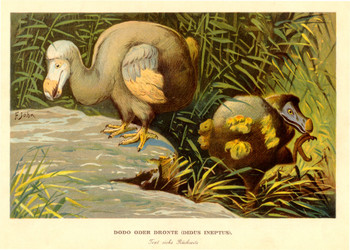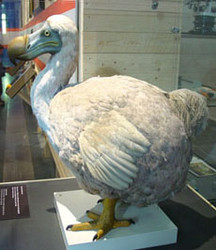

Dodo Bird. German illustration of "Der Dronte", the dodo (1890)by the artist F. John entitled Dodo oder Dronte (Didus Ineptus)http://www.davidreilly.com/dodo/gallery.html
TAXONOMY:
Kingdom: Animalia
Phylum: Chordata
Class: Aves
Order: Columbiformes
Family: Raphidea
Genus: Ralphus
Species: R. Cucullatus
WHO WAS THE DODO?
In 1598 a ship of Portuguese sailors landed on the island of Mauritius and discovered, a previously unknown species of bird, known today as the Dodo Bird. This bird was like nothing they had ever seen before, and having been living in solitude on the island with no natural predators it was a surprisingly fearless. The sailors however mistook this for stupidity therefore giving the bird its name, the “dodo”. Over the course of the next century the dodo was killed by humans and other non-indigenous animals that were brought with them and less then 100 years after it was discovered, it was completely wiped out. The Dodo remains one of the most widely known cases of animal extinctions.
There are a few different speculations on what the Dodo bird originally looked like. Since there were no cameras in the 1500’s all we have to rely on is the portrayal and descriptions of the birds in sailor’s journals, and artist’s renditions. However, since it was such an unusual looking creature there is quite an array of drawings and painting still in existence.
Based on this info, it was determine that a full-grown adult Dodo was a very large bird weighing about 50 lbs. It had grayish blue feathers that covered its body except for a plume of white feathers on its rear. The Dodo had a short neck and stood about 3 feet high on two stout yellow legs. It had two very small wings making it flightless, and a large black beak with bronzed color on the tip. Most portraits of the Dodo portray the bird as very heavy and somewhat clumsy looking, however due to new research and discoveries those previous ideas have been revamped. Many scientists now believe that the bird may have been much slimmer (by about 4 or 5 pounds). The reason that early depictions of the bird may have made it look heavy was due to the fact that it was also known as a very greedy bird, with an insatiable appetite.
Comparison of the physical appearance of the Dodo Bird
The photo on the top (directly below) is a reconstruction of the Dodo Bird based on earlier depictions, whereas the one on the bottom is a newer reconstruction of how scientists now believe that the bird may have actually looked.


Ralphus R. Cucullatus. © 2006 Peter Maas


Ralphus R. Cucullatus. © 2006 Peter Maas Photographed by Peter Maas (2002) at a temporary dodo exposition in the National Museum of Natural History 'Naturalis' in Leiden, the Netherlands http://www.petermaas.nl/extinct/speciesinfo/dodobird.htm
The Dodo was a nesting bird, and chose to settle in grassy areas of the forest floor. The dodo was thought to be a monogamous bird meaning that it mated with only one partner for it’s entire life. Like all birds, it laid eggs, but usually only one at a time. The incubation period was about 49 days, and both parent participated in caring for the young once they hatched.
The Dodo inhabited the island of Mauritius, off the coast of Africa (east of Madagascar) which up until the 1500’s had been uninhabited by humans.


Mauritius Highlighted in Red
The climate on the island is tropical, with a warm, dry winter from May to November and a hot, wet, and humid summer from November to May. The island is also affected by cyclones during November-April.
The fact that these birds were flightless and fearless (from evolving on an island with no natural predators) made them easy prey for the sailors that frequented the island. The taste was not said to be all that wonderful, but because it was an easy meal they were killed in large numbers, which is one of the things that led to their extinction. Once the island was colonized there was an introduction of other animals to the island including cats, dogs, pigs, rats, sheep, and even some monkeys. This meant that not only did the dodos now have human predators; they also had other animals that were chasing them, trampling over their nests and possibly even transmitting disease that the birds had never come into contact with.
There are very few skeletal or genetic remains left to study of the Dodos. The only full skeleton of a Dodo bird lives in the The Natural History Museum of Mauritius; all other remains are either partial (like heads or feet) or skeletons that have been constructed using many different specimens. Recent studies of some fractional genetic remains, found in the skull of a Dodo, have revealed that the bird is very closely related to the modern day pigeon. However the most closely related bird of its time was the Rodriquez Solitaire. The Solitaire was of similar stature to the Dodo and lived on the island of Rodriquez, which is one of the Mascarene Islands and a dependency of Mauritius. It too became extinct much in the same way that the Dodo was wiped out, close to 100 years after the Dodo; however it’s young were considered a delicacy so there was an even heavier human impact on it’s demise.
Although Dodos became extinct close to 300 years ago they are still acknowledged in modern culture. The most recent example is the depiction of the dodo bird as hungry, greedy, and stupid prehistoric bird in the Blue Sky Studios computer animated feature Ice Age. In the scene of the film where they are featured, a flock of Dodos is trying to protect their stash of food from the main characters. After a series of comical events involving the birds, their large fruits accidentally roll off the side of the cliff and the birds chase after them until every last one of them has fallen, essentially leading to their extinction.
The second portrayal that can be recalled is that of the crazy bird in the Looney Toon cartoons that we all used to watch as children. In all the episodes that the bird was featured in, it was made out to be a crazed alien looking bird that lived in some wacky town.
Even though these depictions are not necessarily accurate it is still interesting that after so many years of non existence and so little known about them they are still being kept alive in our mind through these outlets.
The last confirmed sighting of a Dodo bird was in, 1662 only about 100 years after it was first discovered. The tragedy behind the way in which this remarkably unique bird became extinct is a reminder to all of us, to the amount of harm we can bring to a species without even realizing what we are doing. It is important to help preserve what we have on this earth now because there is no telling how long it will last.

 Go to quick links
Go to quick search
Go to navigation for this section of the ToL site
Go to detailed links for the ToL site
Go to quick links
Go to quick search
Go to navigation for this section of the ToL site
Go to detailed links for the ToL site